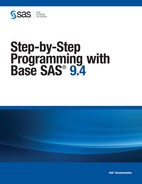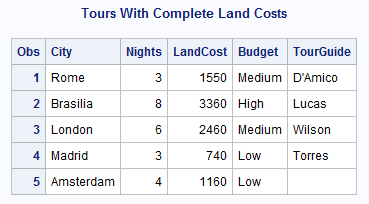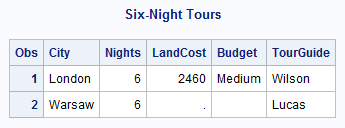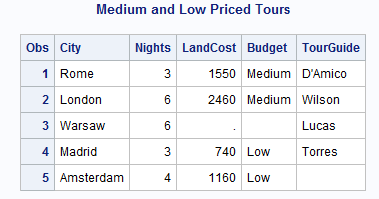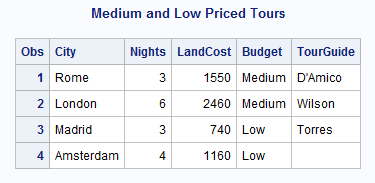Selecting Observations for a New SAS Data Set
Deleting Observations Based on a Condition
There are two ways to select specific observations in
a SAS data set when you create a new SAS data set:
To delete an observation,
first identify it with an IF condition, and then use a DELETE statement
in the THEN clause:
IF condition THEN
DELETE;
Processing the DELETE
statement for an observation causes SAS to return immediately to the
beginning of the DATA step for a new observation without writing the
current observation to the output DATA set. The DELETE statement does
not include the observation in the output data set, but it does not
delete the observation from the input data set. For example, the
following statement deletes observations that contain a missing value
for LandCost:
if LandCost=. then delete;
data remove;
set mylib.arts;
if LandCost=. then delete;
run;
proc print data=remove;
title 'Tours With Complete Land Costs';
run;Warsaw, the observation
that is missing a value for LandCost, is not included in the resulting
data set, REMOVE.
You can also delete
observations as you enter data from an external file. The following
DATA step produces the same SAS data set as the REMOVE data set.
Accepting Observations Based on a Condition
One data set that is needed by the travel agency contains
observations for tours that last only six nights. One way to make
the selection is to delete observations in which the value of Nights
is not equal to 6:
if Nights ne 6 then delete;
A more straightforward
way is to select only observations meeting the criterion. The subsetting
IF statement selects the observations that you specify. It contains
only a condition:
IF condition;
The implicit action
in a subsetting IF statement is always the same: if the condition
is true, then continue processing the observation. If it is false,
then stop processing the observation and return to the top of the
DATA step for a new observation. The statement is called subsetting
because the result is a subset of the original observations. For example,
if you want to select only observations in which the value of Nights
is equal to 6, then you specify the following statement:
if Nights = 6;
data subset6;
set mylib.arts;
if nights=6;
run;
proc print data=subset6;
title 'Six-Night Tours';
run;Comparing the DELETE and Subsetting IF Statements
These are the main reasons to consider when choosing
between a DELETE statement and a subsetting IF statement:
One additional situation
favors the subsetting IF: it is the safer method to use if your data
has missing or misspelled values. Consider the following situation.
Tradewinds Travel needs
a SAS data set of low-priced to medium-priced tours. Knowing that
the values of Budget are
Low, Medium,
and High, a first thought would be
to delete observations with a value of High.
The following program creates a SAS data set by deleting observations
that have a Budget value of HIGH:
/* first attempt */
data lowmed;
set mylib.arts;
if upcase(Budget)='HIGH' then delete;
run;
proc print data=lowmed;
title 'Medium and Low Priced Tours';
run;The data set LOWMED
contains both the tours that you want and the tour to Warsaw. The
inclusion of the tour to Warsaw is erroneous because the value of
Budget for the Warsaw observation is missing. Using a subsetting IF
statement ensures that the data set contains exactly the observations
that you want. This DATA step creates the subset with a subsetting
IF statement:
/* a safer method */
data lowmed2;
set mylib.arts;
if upcase(Budget)='MEDIUM' or upcase(Budget)='LOW';
run;
proc print data=lowmed2;
title 'Medium and Low Priced Tours';
run;..................Content has been hidden....................
You can't read the all page of ebook, please click here login for view all page.
